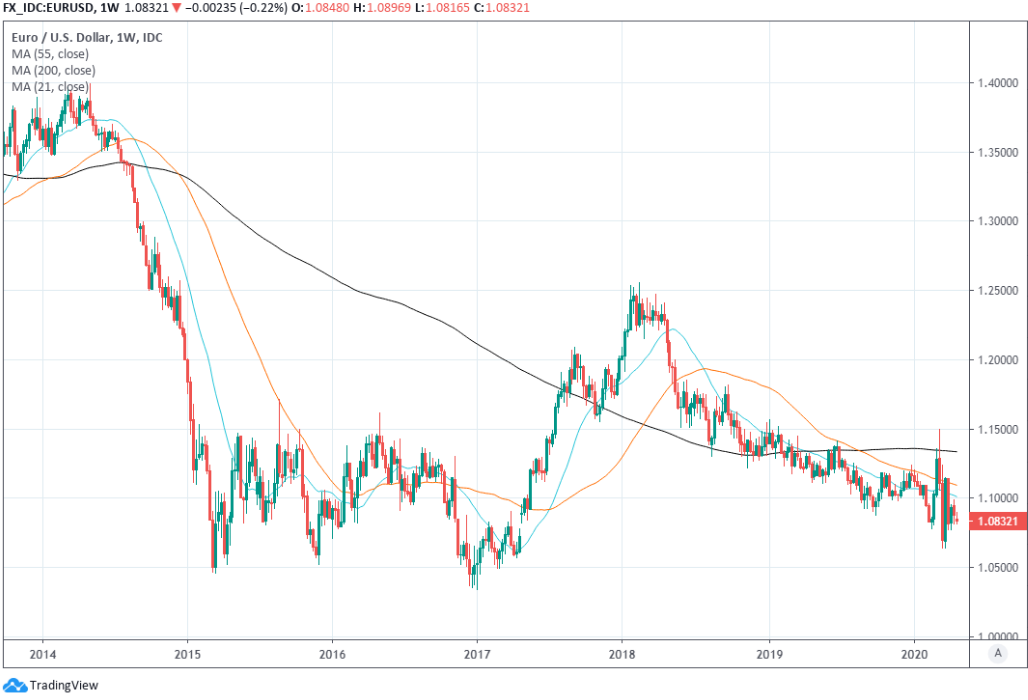Euro-to-Dollar Rate Slips Lower ahead of Make-Or-Break EU Meeting Thursday
- Written by: James Skinner

© Grecaud Paul, Adobe Stock
- EUR/USD spot at time of writing: 1.0833
- Bank transfer rates (indicative): 1.0333-1.0408
- FX specialist rates (indicative): 1.0673-1.0739 >> More information
The Euro-to-Dollar rate slipped lower on Wednesday in spite of a global rebound for risk assets and ahead of a crunch European Council meeting that will matter greatly to the short and long-term outlook for the single currency.
Europe's single currency has trodden water through much of this week, leaving last week's low of 1.0812 intact, but it faces a long and uphill climb all the way back to 1.1167 alleviate the selling pressures that have weighed heavily on it since early March. However, leaving that low intact again and countering those selling pressures could become a pipe dream on Thursday if the European Council video conference meeting ends without leaders having agreed an adequate European response to the coronavirus crisis.
This is after the Eurogroup of finance ministers agreed a €540bn funding package for troubled member states a fortnight ago. There's uncertainty over whether that will be endorsed by those likely to need it the most, given that it requires countries to tap a crisis era 'bailout' fund, although markets will also be keen for details on an eagerly anticipated 'recovery fund' that's expected to accomodate the bulk of the additional European response
The short and long-term outlook for the Euro is hinged at least in part on whether national leaders can agree a mechanism through which the bloc can finance the 'recovery fund' and collectively defend its weakest members from crisis era threats that have returned with the coronavirus to haunt some of its most needy members. These mebers are also those hit hardest by the coronavirus and whose economies have suffered longest under the 'lockdown' strategies favoured as a means of containing the disease.
"EUR/USD continues to be essentially side-lined above last week’s low at 1.0812 below which lie the 1.0778/69 mid-February and current April lows. Failure at 1.0769 would target the 1.0636 March low and then 1.0340, the 2017 low.," says Karen Jones, head of technical analysis for currencies, commodities and bonds at Commerzbank. "A rise above the 61.8% Fibonacci retracement at 1.1167 would be needed for the December high at 1.1240 to be back in play."

Above: Euro-to-Dollar rate shown at daily intervals with Fibonacci retracements of March downtrend.
The coronavirus-induced economic standstill has weighed heavily on the Euro and lifted the value of the Dollar but it's the financial damage being done by the containment efforts and the myriad possible implications of the fractious debate in Europe over the correct fiscal response that's increasingly weighing on Euro-to-Dollar rate forecasts. The Euro entered 2020 with the market looking for it to end the year around 1.15 but 1.05 is now a more common forecast, while some even see it falling as low as 1.02. Thursday's meeting be key in determining just how low the Euro will go in the weeks and months ahead.
Italy, Spain and other 'periphery' countries have the highest debt burdens and face the greatest costs as a result of the coronavirus, but with bond markets increasingly discerning of prospective borrowers, those countries are seeking 'coronabonds' or some other form of mutualised debt to finance their recoveries. However, some Central and North European countries have objected to financing the spending of peoples often painted and perceived on the continent as having been profligate in their past spending.
"The debt distribution will be VERY imbalanced once the shock is over – both at the sovereign and sub-sovereign level. The hardest hit countries are also the ones with largest debt piles – most notably Italy. PM Conte did indicate on Tuesday that he’s willing to work with the EU on drawing from the ESM credit line, but that comes with conditionality that his political opponents (especially Salvini’s LN) will hammer him on. Also, his coalition partner (5-star) is on the verge of breaking up over the issue," says Bipan Rai, North American head of FX strategy at CIBC Capital Markets. "In our view – the best way to stabilize peripheral spreads on a long-term basis is for Eurozone leaders to show solidarity when it comes to pan-Euro funding."
Bond market concerns about the likely level of borrowing in some countries have lifted yields toward problematic levels, as measured by the difference between yields on periphery country bonds and those of the safe-have alternatives that are negative-yielding German government bonds. "Problematic levels" are thought by some strategists to be anything above the likely average rate of nominal GDP growth over a given horizon, and the spread between yields on Italian and German bonds was at 1.89% on Wednesday. That's higher than Italian GDP growth has been in most years since the debt crisis.
Such bond spreads are small compared to those seen during the debt crisis when Italian yields rose past +7.5%, but this says more about the lengths the European Central Bank (ECB) has gone to with its quantitative easing programme than it does the severity of the current problem.

Above: Euro-to-Dollar rate shown at weekly intervals.
The ECB also appeared to urge the European Council toward a solution this week in letters to EU parliamentarians from President Christine Lagarde and an editorial on the home page of its website, wrriten by an executive board member and carrying the headline; "Why we all need a joint European fiscal response."
Central and Northern European leaders will be asked again by 'periphery' countries to put political and economic self-interest aside, in the same way some might argue those country's leaders did when advocating bitter post-crisis medicines and a keeping of the European faith among their own electorates. That didn't work out well for many of those periphery country leaders neglecting to oblige in their favour this time, even if only for a time limited period, would be close to the act of abandoning those countries and their leaders at a time when anti-Euro sentiments have already been stoked in Italy.
Bond markets could say no when asked to finance the weaker and more financially vulnerable countries if there is no European fiscal solution and funding requirements grow sufficiently, and with the ECB unable to lend directly to governments there might not be much it could do in order to save those countries under such circumstances. Such circumstances, or even just concerns about them being a possibility, are not the stuff that Euro recovery rallies are made out of. Then there's the political consequences, which could dog the Euro until long after the pages of history have been turned on the coronavirus.
Italy has garnered a lot of the market's attention to date but that limelight could quickly be stolen by France in the event of a European Council calamity on Thursday given that President Emmanuel Macron will be weighed and measured at the ballot box before any Italian lawmakers are. The most ardent advocate of European integration among national leaders saw off a potent threat to the single currency in the form of Marine Le Penn back in 2017 but who came into the coronavirus crisis having himself been dogged by more than a year of increasingly violent protests over things like carbon taxes and pension reforms, both of which have roots in the European Council chamber.
"Even if EU leaders this week reach an agreement on a COVID-19 recovery program funded by mutually guaranteed debt (a big if), this would not solve underlying problems for two reasons. The first is the subject of "legacy issues", which are responsible for the pre-existing extent of financial fragmentation (i.e. Italian & Dutch banks are not viewed equally). The second is that jointly-issued debt is not the same thing as "being handed the keys to the car" for the Southern member states. In fact, mutual debt obligations could make the thorny issues of apportioning the proceeds of new issuance, and conditionality, even worse," says Stephen Gallo, European head of FX strategy at BMO Capital Markets. "We would be comfortable remaining short EURUSD at current levels, and continue to view the 1.10 area as solid resistance."




